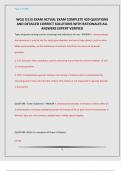Page 1 of 242
WGU D115 EXAM ACTUAL EXAM COMPLETE 420 QUESTIONS
AND DETAILED CORRECT SOLUTIONS WITH RATIONALES ALL
ANSWERS EXPERT VERIFIED
Types of genetic testing (carrier screening) and indications for use - ANSWER-1. Amniocentesis.
Amniocentesis is used to test for single gene disorders and neural tube defects, such as spina
bifida and ancephaly, via the withdrawal of amniotic fluid from the uterus at 16 weeks
gestation.
2. CVS. Chorionic villus sampling is used by extracting tissue from the chorion between 10 and
12 weeks gestation.
3. PGD. Preimplantation genetic testing is the testing of embryos prior to implantation by
extracting one to two cells from the embyro. The embyro is not implanted if a genetic disorder
is discovered.
QUESTION: Turner Syndrome - ANSWER-A chromosomal disorder in females in which either an
X chromosome is missing, making the person XO instead of XX, or part of one X chromosome is
deleted. Signs are: short stature, webbed neck, widely spaced nipples.
QUESTION: Which is a symptom of Grave's Disease?
Lid lag
1
,Page 2 of 242
Lethargy
Cool, moist skin
Decreased sympathetic response - ANSWER-Lid Lag.
Feedback: Symptoms of Graves' disease include anxiety, hand tremor, heat sensitivity, weight
loss, puffy eyes, lid lag, and enlarged thyroid.
QUESTION: Cri du chat syndrome - ANSWER-A deletion of the short arm of chromosome 5
associated with an array of congenital malformations. Cri du chat syndrome can present as a
microcephalic, low birth-weight baby with a piercing cry.
QUESTION: Types of Immunity - ANSWER-Active natural: Body produces antibodies in response
to exposure to a live pathogen.
Active artificial: Body produces antibodies in response to a vaccine.
Passive natural: Antibodies are passed from the mom to her baby through the placenta and
breastmilk.
Passive artificial: Immunoglobulins are administered to an individual after exposure to a
pathogen.
2
,Page 3 of 242
QUESTION: systemic lupus erythematosus (SLE) - ANSWER-Systemic lupus erythematosus (SLE),
is the most common type of lupus. SLE is an autoimmune disease in which the immune system
attacks its own tissues, causing widespread inflammation and tissue damage in the affected
organs. It can affect the joints, skin, brain, lungs, kidneys, and blood vessels. Symptoms include:
Malar rash, Ulcers/mucocutaneous involvement, Kidney involvement, proteinuria, urinary
cellular casts, Seizures, Thrombocytopenia, Hemolytic anemia, Fever, Lymphadenopathy.
QUESTION: Down Syndrome - ANSWER-a condition of intellectual disability and associated
physical disorders caused by an extra copy of chromosome 21 (trisomy 21)
QUESTION: Cardinal signs of infection - ANSWER-redness, heat, swelling, pain, loss of function
QUESTION: Which type of genetic disease affects males more frequently than females? -
ANSWER-Sex-linked recessive. Since males have only one X and one Y, if the affected
chromosome has the illness, it will be expressed.
3
, Page 4 of 242
QUESTION: In which two conditions are chromosomal abnormalities the leading known cause? -
ANSWER-Chromosome abnormalities are the leading known cause of intellectual disability and
fetal miscarriage.
QUESTION: What are three examples of prenatal diagnostic studies? - ANSWER-PGT, CVS,
Amniocentesis. Chorionic villus sampling (CVS), amniocentesis, and preimplantation genetic
testing (PGT) are examples of prenatal diagnostic studies and are performed in vitro. CVS is a
form of genetic testing that provides genetic information found in utero and is usually
performed between weeks 11 and 14 of pregnancy. An amniocentesis is a form of genetic
testing that evaluates amniotic fluid and is usually performed during the second trimester,
between weeks 15 and 20 of pregnancy. PGT is performed on the embryo prior to implantation.
QUESTION: Which genetic disorder is characterized by the presence of a zygote having one
chromosome with a normal complement of genes and one chromosome with a missing gene? -
ANSWER-Cri du chat syndrome (translated as "cry of the cat") is caused by a DNA deletion. This
term describes the cry often heard from a baby affected by the syndrome. Cri du chat
syndrome can present as a microcephalic, low birth-weight baby with a piercing cry.
4




